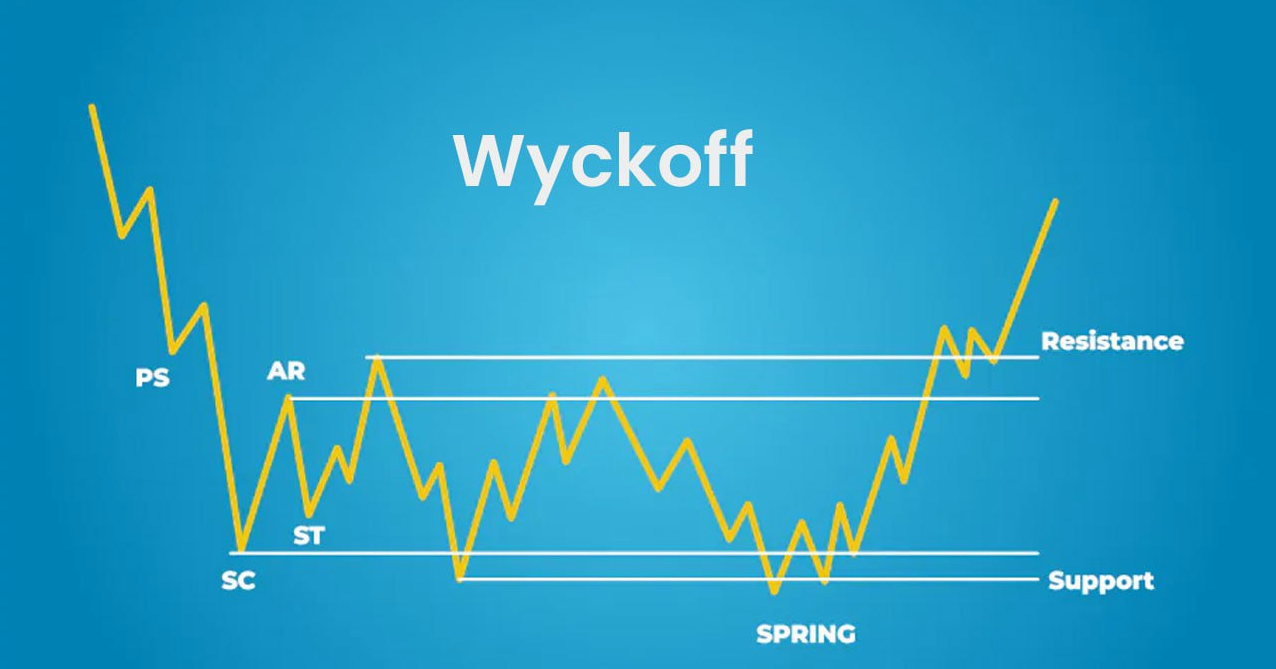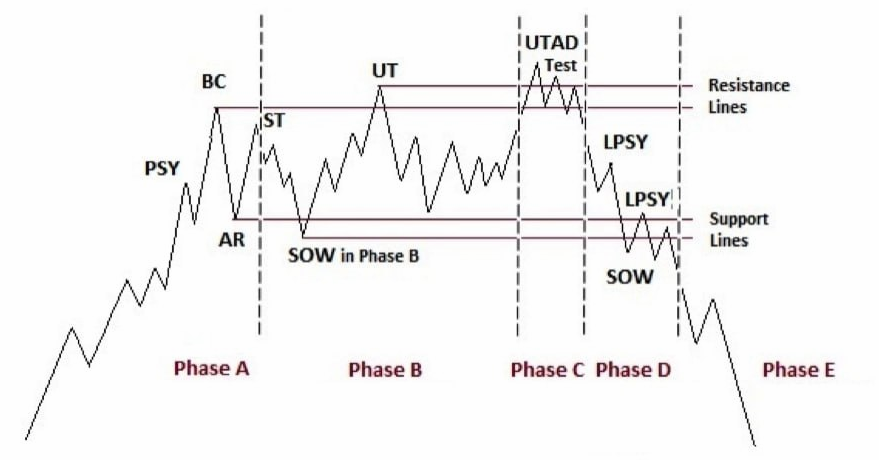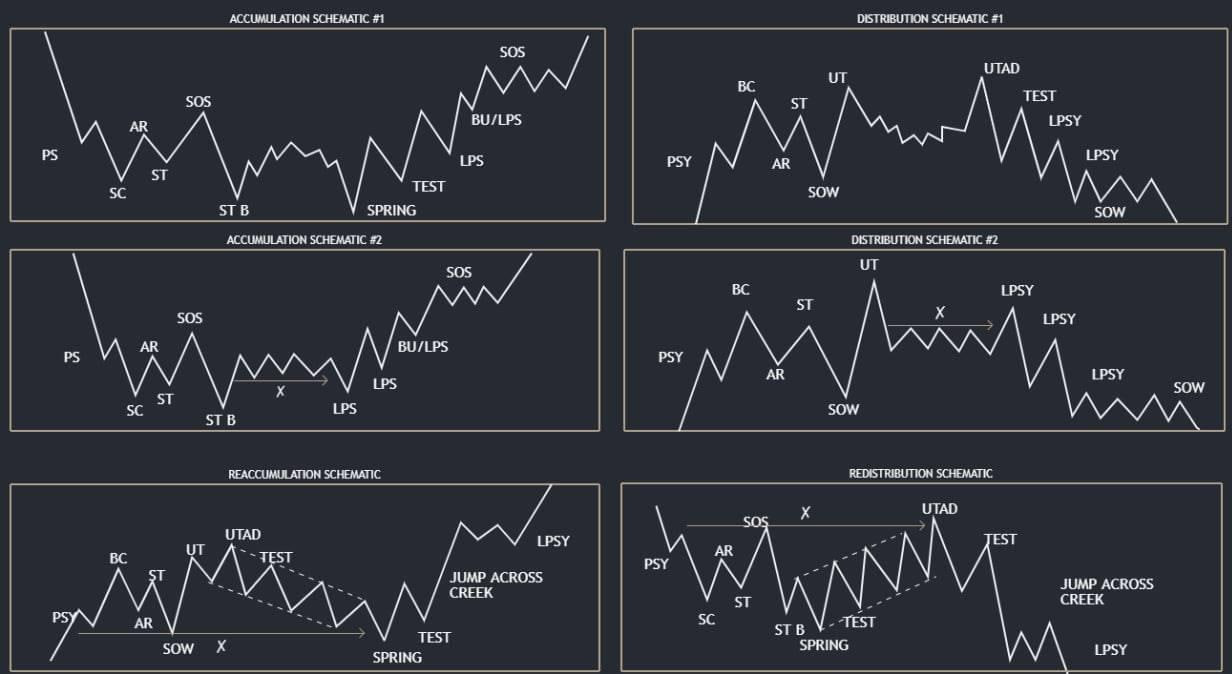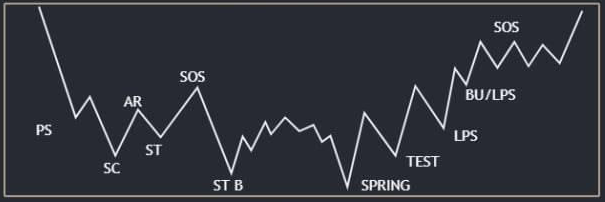TL;DR Key Takeaways
TL;DR
- The Wyckoff strategy is a market analysis method that helps traders identify accumulation, distribution, and trend phases.
- To maximize accuracy, traders should analyze the Wyckoff schematics, confirm market phases, and use volume and price action for validation.
Richard Wyckoff’s methodology is one of the most powerful trading strategies, providing insights into institutional market behavior. This strategy allows traders to anticipate price movements by understanding the interplay of supply and demand. In this article, we’ll explore how the Wyckoff strategy works, its phases, and how traders can integrate it into their trading plan. Let’s dive in.
Understanding the Wyckoff Strategy
If you’ve ever wondered “How can I use the Wyckoff method in trading?” or “What is the Wyckoff accumulation and distribution model?”, the answer lies in its core principles. Wyckoff’s strategy revolves around studying market cycles, classifying them into different phases, and understanding how institutional traders manipulate price movements.

The Five Key Steps of the Wyckoff Method:
- Determine the Market’s Present Position – Identify whether the market is in accumulation, distribution, or trending mode.
- Identify the Strongest Stocks or Assets – Find assets that align with the dominant trend.
- Select Assets with a Cause – Use the Wyckoff accumulation and distribution model to evaluate whether there is strong potential for a move.
- Assess the Likely Future Direction – Determine whether an asset will move up or down based on the phases.
- Time Entries and Exits Efficiently – Use price action, volume, and market structure to time trades.
.
The Wyckoff Market Cycle: Accumulation and Distribution Phases
The Wyckoff strategy divides the market into four main phases:
- Accumulation – A sideways range where large institutions accumulate assets at lower prices before a trend begins.
- Markup (Uptrend) – The price moves higher as demand exceeds supply, leading to a bullish trend.
- Distribution – A range where large institutions distribute assets to retail traders before a downtrend.
- Markdown (Downtrend) – The price moves lower as supply overtakes demand, leading to a bearish trend.

Each phase follows a specific structure, consisting of events such as Spring (shakeout), Test, Breakout, and Retest in the accumulation phase, and Upthrust, Last Point of Supply (LPSY), and Breakdown in the distribution phase.
Wyckoff’s Schematics: Accumulation vs. Distribution
Wyckoff’s methodology outlines distinct price structures that traders can use to anticipate market reversals:
Accumulation Schematic (Bullish)
- Preliminary Support (PS) – First signs of institutional buying.
- Selling Climax (SC) – A sharp decline followed by strong buying activity.
- Automatic Rally (AR) – A quick price bounce after the SC.
- Secondary Test (ST) – Price retests the SC level to confirm demand.
- Spring – A final shakeout that traps sellers before a major uptrend.
- Breakout and Retest – Price moves above resistance and confirms a new trend.
Distribution Schematic (Bearish)
- Preliminary Supply (PSY) – First signs of institutional selling.
- Buying Climax (BC) – A strong upward move followed by heavy selling.
- Automatic Reaction (AR) – A quick drop due to selling pressure.
- Secondary Test (ST) – Price retests the BC level to confirm supply.
- Upthrust (UTAD) – A false breakout that traps buyers before a sell-off.
- Breakdown and Retest – Price falls below support and confirms a new trend.

Confirmation: The Key to Wyckoff Trading Success
To improve trade accuracy, traders should confirm Wyckoff patterns using:
- Volume Analysis – Increasing volume near critical price levels strengthens confirmation.
- Price Action Signals – Look for bullish or bearish candles at key levels.
- Trend Alignment – Ensure that Wyckoff phases align with the larger market trend.
- Breakout Retests – Enter trades after retests of breakout levels.
Why Context Matters
Using the Wyckoff strategy in isolation can lead to false signals. Here’s why context is essential:
- The strategy works best when paired with broader market trends.
- Institutional traders often use manipulation tactics to create false breakouts.
- Combining Wyckoff analysis with momentum indicators improves trade timing.
Time Frames for Using the Wyckoff Strategy
The Wyckoff strategy is applicable across multiple time frames, making it suitable for different trading styles:
- Day Traders – Use intraday charts (e.g., 5-minute, 15-minute) to spot quick accumulation and distribution setups.
- Swing Traders – Look for Wyckoff phases on daily charts to capture larger trend movements.
- Position Traders – Identify Wyckoff cycles on weekly or monthly charts for long-term investing.
Regardless of the time frame, traders should wait for confirmation before executing trades.
Example: How to Use the Wyckoff Strategy in Trading
Imagine Bitcoin is in an accumulation phase. Here’s how to trade it:
- Identify Preliminary Support, Selling Climax, and Automatic Rally in a sideways range.
- Watch for a Spring (false breakdown) to trap sellers.
- Confirm the breakout above resistance with high volume.
- Enter a long position after the retest of resistance.
- Place a stop-loss below the Spring level.
- Set a profit target based on the markup phase projection.

This methodical approach allows traders to profit from Wyckoff patterns while managing risk effectively.
Limitations of Trading Based on the Wyckoff Strategy
Despite its effectiveness, the Wyckoff strategy has limitations:
- Market Manipulation – Institutions can create false signals to mislead retail traders.
- False Breakouts – Accumulation or distribution phases can last longer than expected.
- Complexity – Understanding Wyckoff phases requires practice and experience.
Using complementary indicators like RSI and MACD can help mitigate these risks.
Stay ahead of the market
with Tealstreet
Final Thoughts
The Wyckoff strategy remains one of the most effective methods for understanding market cycles and institutional behavior. By mastering accumulation, distribution, and price action, traders can significantly enhance their trading decisions. Whether trading stocks, forex, or crypto, Wyckoff’s principles provide an edge in navigating market trends.
Ready to enhance your trading? Tealstreet offers fast execution, intuitive controls, and advanced analytics to help you trade where you are.
Wyckoff Strategy FAQs
1. How can I identify Wyckoff accumulation on a chart?
Look for sideways movement with increasing volume near key support levels.
2. Is the Wyckoff method reliable?
Yes, but confirmation using volume and price action is essential to avoid false signals.
3. Can I use the Wyckoff strategy in all markets?
Yes, Wyckoff principles apply to stocks, forex, crypto, and commodities.
4. What is the best time frame for using the Wyckoff strategy?
It works across all time frames, but higher time frames (daily, weekly) offer stronger signals.


